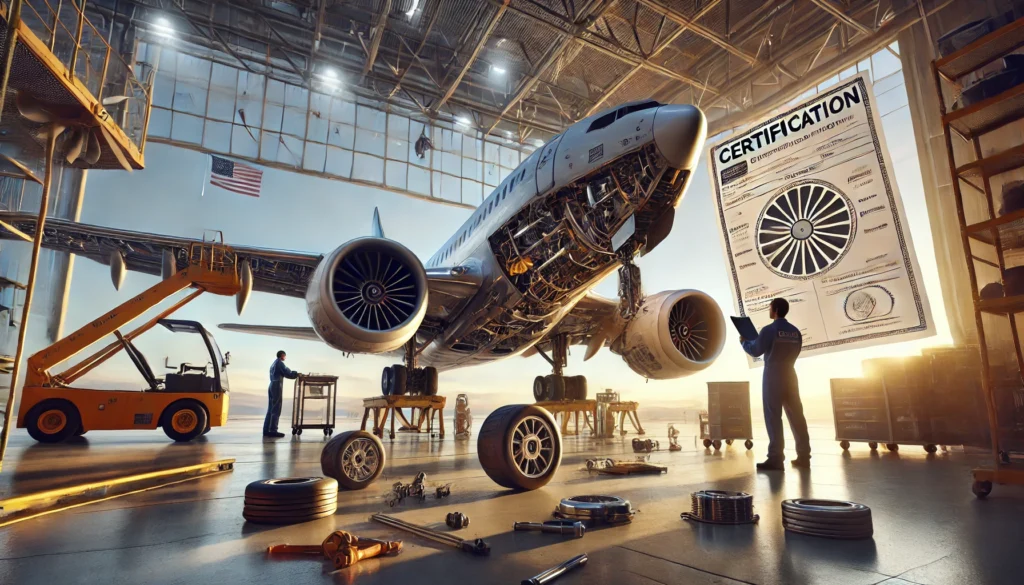In the world of aviation, flying isn’t just about reaching new heights; it’s about ensuring that every journey is safe and sound. Picture this: a bustling airport, planes soaring through the sky, and passengers blissfully unaware of the rigorous standards that keep them secure at 30,000 feet.
Behind the scenes lies a crucial element often overlooked—airworthiness certification. It’s not merely a stamp on a piece of paper; it’s a comprehensive promise that an aircraft meets strict safety regulations and performance standards. Join us as we delve into why airworthiness matters more than ever, exploring how certification safeguards lives, enhances operational efficiency, and fosters public confidence in aviation.
Buckle up as we take off into the fascinating world where technology meets trust!
Introduction to Airworthiness and Certification in Aviation
Air travel is one of the most remarkable achievements of modern technology, connecting people and cultures across the globe. Yet, behind every smooth flight lies an intricate web of regulations and standards ensuring that each aircraft is safe for takeoff. At the heart of this system is a crucial concept: airworthiness. This term encompasses everything from structural integrity to maintenance practices, playing a pivotal role in ensuring that planes remain reliable as they soar through the skies.
But what exactly does airworthiness mean? And why should it matter to anyone who steps onto an aircraft? By understanding airworthiness and its certification process, passengers can feel more confident about their safety during flights. Join us as we unravel the complexities surrounding airworthiness and explore how it safeguards lives while elevating our aviation experience.
What is Airworthiness?
Airworthiness refers to the condition of an aircraft that ensures it is safe and fit for flight. It encompasses a variety of factors, from design and manufacturing standards to maintenance practices.
A key aspect involves compliance with specific regulations set by aviation authorities. These rules dictate the minimum safety requirements necessary for an aircraft to operate effectively.
An airworthy aircraft must be free from defects that could jeopardize its performance or passenger safety. This includes everything from engine functionality to structural integrity.
Regular inspections and assessments play a vital role in maintaining airworthiness throughout an aircraft’s lifespan.
Ultimately, it’s about ensuring reliability so that flights can proceed without undue risk, safeguarding both crew members and passengers alike.
The Importance of Airworthiness in Ensuring Aircraft Safety
Airworthiness is the backbone of aviation safety. It ensures that an aircraft meets strict standards before it takes to the skies. This oversight helps prevent accidents and protects passengers, crew, and cargo.
Every component of an aircraft must function properly for safe operation. From engines to navigation systems, airworthiness checks guarantee reliability in all conditions.
Regular inspections and maintenance are crucial elements in sustaining airworthy status. These practices identify wear or potential failure points before they become critical issues.
Moreover, understanding airworthiness fosters a culture of accountability within the industry. Manufacturers, operators, and regulatory bodies share responsibility for maintaining high safety standards.
Ultimately, prioritizing airworthiness significantly reduces risks associated with flying. When every flight commences with verified structural integrity and operational capability, confidence grows among everyone involved in aviation travel.
Understanding the Airworthiness Certificate
The Airworthiness Certificate is a critical document in aviation. It signifies that an aircraft meets specific safety standards set by regulatory authorities.
This certificate is not just a piece of paper; it represents rigorous inspections and assessments conducted on the aircraft. Only after thorough evaluations can an aircraft be deemed airworthy.
There are two primary types of Airworthiness Certificates: Standard and Special. Each serves different purposes, depending on the type of operation or modification involved.
Obtaining this certificate ensures that pilots and passengers have confidence in their flight experience. It underscores the commitment to maintaining high safety levels throughout an aircraft’s operational life.
Without it, airlines and private operators could face severe consequences, including fines or grounding orders. Thus, understanding its significance is vital for anyone interested in aviation’s intricacies.
How is an Aircraft Certified as Airworthy?
The journey to certifying an aircraft as airworthy is a meticulous process. It begins with rigorous inspections and tests of the aircraft’s design, components, and systems. These evaluations ensure that everything meets strict safety standards.
Next comes the documentation phase. Manufacturers must provide detailed records of compliance with regulatory requirements. This includes maintenance logs and proof of successful testing.
After thorough scrutiny, independent inspectors examine every aspect before granting approval. Their expertise ensures no detail is overlooked.
If any issues arise during these checks, necessary adjustments or repairs are mandated prior to certification. This step guarantees the aircraft operates safely under various conditions.
Once cleared by inspectors, an airworthiness certificate is issued. This document signifies that the aircraft meets all legal criteria for safe operation in flight.
Common Misconceptions about Airworthiness
Many people assume that airworthiness is solely about the aircraft’s physical condition. While this aspect is crucial, it’s only part of the equation. Airworthiness encompasses various factors including maintenance practices, pilot proficiency, and adherence to regulations.
Another misconception is that once an aircraft receives its airworthiness certificate, it remains valid indefinitely. In reality, ongoing inspections and regular maintenance are necessary to maintain this status.
Some believe that only new aircraft can be certified as airworthy. However, older planes can also meet stringent requirements if they undergo proper evaluations and modifications.
Lastly, there’s a myth that all airlines prioritize safety equally because of certification standards. Unfortunately, varying levels of commitment exist across different operators regarding adherence to safety protocols linked to maintaining airworthiness.
The Role of Government Agencies in Ensuring Airworthiness
Government agencies play a pivotal role in maintaining airworthiness standards. They establish regulations that govern aviation safety, ensuring all aircraft meet stringent criteria.
These organizations, such as the Federal Aviation Administration (FAA) and the European Union Aviation Safety Agency (EASA), oversee certification processes. Their experts conduct inspections and audits to verify compliance with safety protocols.
Additionally, these agencies collaborate with manufacturers and operators. This partnership helps identify potential risks early on. By fostering communication between stakeholders, they enhance overall safety measures in aviation.
Regular updates to regulations reflect advancements in technology and emerging industry challenges. As new data becomes available, government bodies adapt their guidelines accordingly.
Public trust hinges on the effectiveness of these agencies. When people board an aircraft, they rely on rigorous oversight to guarantee their safety at 30,000 feet above ground.
International Standards and Regulations for Airworthiness
International standards and regulations for airworthiness are essential in maintaining global aviation safety. Organizations like the International Civil Aviation Organization (ICAO) set benchmarks that countries strive to meet.
These standards cover a wide range of factors, from design and manufacturing processes to maintenance protocols. Countries adopt these guidelines into their own regulatory frameworks, ensuring consistency across borders.
Moreover, regional bodies such as the European Union Aviation Safety Agency (EASA) play a vital role in enforcing airworthiness criteria specific to their jurisdictions. This collaboration promotes safe practices while allowing for variations tailored to local needs.
As aircraft technology evolves, so too do these regulations. Continuous updates ensure that new innovations align with established safety protocols. The dynamic nature of international airworthiness requirements helps safeguard passengers and crew alike on every flight around the world.
Advancements in Technology and its Impact on Airworthiness
Advancements in technology have dramatically reshaped the landscape of airworthiness. Innovative materials are now being used to construct lighter and more durable aircraft, enhancing fuel efficiency and performance.
Automation plays a pivotal role too. Modern avionics systems provide real-time data, allowing pilots to make informed decisions quickly. Enhanced diagnostic tools can predict maintenance needs before issues arise, ensuring that planes remain safe and sound.
Artificial intelligence is revolutionizing inspections as well. Machine learning algorithms analyze vast amounts of data from previous flights, identifying patterns that human inspectors might overlook.
Moreover, 3D printing has simplified manufacturing processes for parts that meet stringent safety standards. This not only reduces time but also allows for rapid replacements when necessary.
These technological strides contribute significantly to maintaining airworthiness standards while promoting safer skies around the globe. The future looks promising with ongoing innovations driving continuous improvement in aviation safety protocols.
Challenges and Controversies Surrounding Airworthiness Certification
Airworthiness certification faces various challenges that complicate the process. One significant hurdle is the rapid pace of technological advancements in aviation. As new systems and materials are introduced, existing regulations may lag behind, creating uncertainty around what constitutes airworthy.
Additionally, debates often arise about the effectiveness of current testing methods. Some industry experts argue that traditional assessments do not fully capture potential risks associated with modern aircraft designs.
Regulatory bodies also face scrutiny regarding their oversight practices. Questions about transparency and accountability can lead to distrust among stakeholders, including manufacturers and airlines.
Furthermore, differing international standards pose another layer of complexity. With varied approaches to airworthiness across countries, harmonizing these regulations becomes a daunting task for global aviation safety.
Lastly, incidents involving certified aircraft can spark public outrage and demand for stricter measures. This pressure can influence how agencies approach future certifications amid growing concerns over passenger safety.
Conclusion: The Crucial Role of Airworthiness in Aviation Safety
Airworthiness is more than just a technical term; it embodies the essence of aviation safety. Certification processes ensure that every aircraft meets stringent standards before it takes to the skies. This commitment protects not only those onboard but also people on the ground.
The importance of airworthiness cannot be overstated. It acts as a safeguard against potential failures and accidents, which can have devastating consequences. With ongoing efforts from government agencies and adherence to international regulations, safety in aviation remains a top priority.
As technology advances, so too does our understanding of what constitutes airworthy designs and systems. New innovations provide enhanced monitoring capabilities and predictive maintenance solutions that further bolster aircraft reliability.
While challenges remain in maintaining rigorous certification standards amidst rapid technological change, the collective focus on airworthiness holds significant promise for safer skies ahead. An unwavering commitment to these principles will continue to play an essential role in ensuring that flying remains one of the safest modes of transportation available today.

